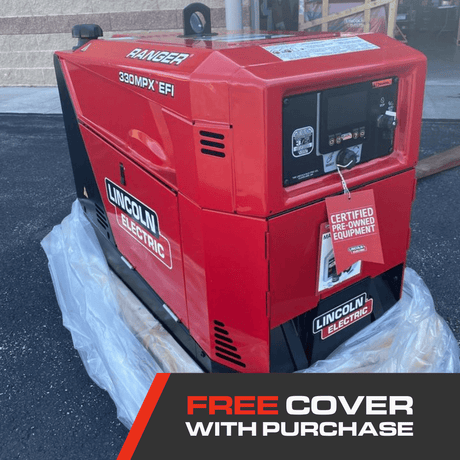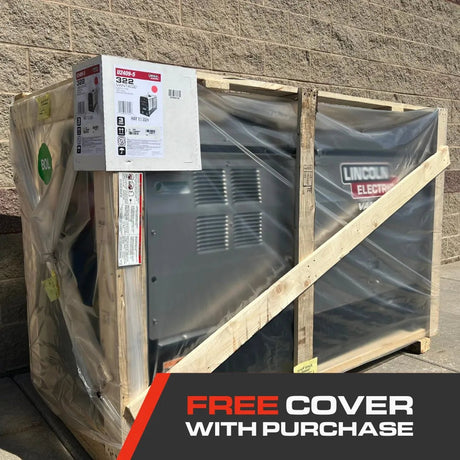Whether you're a professional metal fabricator, automotive repair expert, or a passionate DIY enthusiast, choosing the right MIG welder can transform your welding experience. At WeldingMart, we offer a curated selection of MIG welders—including models like the Lincoln MIG welding machine—that cater to a wide variety of metalworking projects. Ensure your welding systems are supported with the best accessories for your Lincoln MIG welding machine. From light-duty hobbiest machines to POWER MIG 215 and POWER MIG 360MP industrial-grade equipment, our inventory supports both beginners and experienced welders.
MIG Welders
Best-Selling MIG Welders
-
Lincoln Ranger 330MPX EFI Low Hour Factory Demo Engine Driven Welder Generator Kohler - U4779-1
$8,999.00$10,689.99Unit price /UnavailableLincoln ED030611 SureArc S6 .035 33# Spool MIG Wire 81 Rolls Per Pallet / 2,673 lbs Total
$2,799.00Unit price /UnavailableLincoln Power MIG 215 MPi Welder - Factory Demo - U4876-1
4 reviews$1,949.00$2,249.99Unit price /UnavailableLincoln Frontier 400X Low Hour Factory Demo Engine-Driven Welder Kubota - U3484-2
$21,499.00$26,838.00Unit price /UnavailableLincoln Vantage 322 Engine-Driven Low Hour Factory Demo Welder/Generator Kubota - U2409-5
$19,999.00$25,431.00Unit price /Unavailable- Sort by
- Featured
- Best selling
- Alphabetically, A-Z
- Alphabetically, Z-A
- Price, low to high
- Price, high to low
- Date, old to new
- Date, new to old
(44 products)
Filter & Sort FiltersFilter & Sort-
Lincoln Power MIG 360MP Multi-Process Welder Education One-Pak - K4778-1
$9,909.99Unit price /UnavailableLincoln Power MIG 360MP Aluminum Front Trigger One-Pak - K4784-1
$13,409.99Unit price /UnavailableLincoln Power MIG 360MP Multi-Process Factory Demo Welder - U4467-1
$7,499.00$9,099.99Unit price /UnavailableLincoln Power MIG 360MP Multi-Process Welder (No Input Cord) - K4467-2
$8,749.99Unit price /UnavailableLincoln Activ8X Wire Feeder Machine Factory Demo Tweco - U3519-1
$2,750.00$3,383.60Unit price /UnavailableLincoln Power MIG 360MP Aluminum Front Trigger One-Pak for Auto Repair - K4785-1
$13,409.99Unit price /UnavailableLincoln Power MIG 256 MIG Welder One-Pak - Complete Welding Package - K3069-1
$7,274.00Unit price /UnavailableLincoln Power MIG 256 MIG Welder - 230/460/575 Volt, Single Phase, 60 Hz - K3068-2
$5,001.15Unit price /UnavailableLincoln Power MIG 262MP Multi-Process Low Hour Factory Demo Welder - U5376-1
$3,799.00$4,489.99Unit price /UnavailableLincoln Power MIG 256 MIG Factory Demo Welder - U3068-1
$3,999.00$4,471.00Unit price /UnavailableThe Comprehensive Guide to MIG Welders: Features and Uses
Explore the various types, including the Lincoln MIG welding machine and Lincoln POWER MIG models, to find the best fit for your projects.
Introduction to MIG Welding
What Is MIG Welding?
The Multi Process Welder offers versatility by integrating MIG, TIG, and Stick welding. MIG welding is a process that uses a continuous solid wire electrode, fed through a MIG welding machine, like those available from Lincoln Electric, to create a strong joint. During operation, the electrode wire and the metal workpiece are melted together under a shielding gas atmosphere, usually argon or a mixture of argon and carbon dioxide. The MIG flux cored process is another option offered in welding systems like the Multi Process Welder, enhancing capability in various settings. This process is well-known for its ease of use, minimal cleanup, and its ability to produce aesthetically pleasing welds.
Why Choose MIG Welding?
MIG welders are favored for several reasons: - Ease of Learning: Even beginners can quickly achieve strong, consistent welds. With a Lincoln POWER MIG on your cart, you'll find ease in the process. - Versatility: MIG welding can be used on steel, aluminum, copper, and other alloys. The process is fast, enabling rapid project start and efficient completion. The process is fast, enabling rapid project turnaround. - Minimal Cleanup: Unlike stick welding, MIG leaves little slag, reducing post-weld cleaning time.
These advantages make MIG welders ideal for both professional workshops and small home Shop setups.
Key Terms in MIG Welding
Familiarize yourself with terms like Spool Gun and welding systems to better navigate MIG welding.
Understanding MIG Welding Gas Types
The success of MIG welding hinges on the shielding gas, which protects the weld pool from atmospheric contamination: - Argon: Offers stable arcs and is suitable for welding non-ferrous metals like aluminum. - CO₂: More affordable, often used for welding steel, providing deeper penetration. Choose the right welding systems, whether MIG or TIG, for the tasks involving cutting and fabrication. Blends are used to combine different benefits of each gas in MIG flux cored and other welding processes. Blends are used to combine the benefits of each gas for specific materials and situations.
Selecting the right gas depends on the material being welded and the desired weld quality.
Welding wire acts as the filler material and is crucial for both MIG and flux cored welding projects.
Welding wire acts as the filler material and plays a crucial role: - Solid Wire: Used for clean, rust-free metals and produces smooth welds. Utilize accessories like a Spool Gun and welding gun to enhance your capabilities in certain conditions. - Flux-Cored Wire: Contains internal flux for welding outdoors or on dirty/rusty metals, and doesn’t always require shielding gas.
Understanding these basics ensures correct wire selection for each MIG welding project.
Different Types of MIG Welders
Lincoln Electric and Miller both offer a variety of welder machines.
Budget vs. Professional Models
- Budget Models: Ideal for hobbyists, these machines provide essential features powered by systems for small repair and fabrication tasks. - Professional Models: Offer higher power output, advanced controls, and enhanced durability suited for dual process capabilities.
Both types can deliver high-quality results; your choice depends on project complexity and duty cycle requirements. Consider purchasing a Multi Process Welder for its flexibility in working with MIG and TIG welding.
Multi-Process Versatility
Some modern welder machines combine MIG and TIG with other processes such as Stick welding, offering: - Versatility: Ability to tackle different materials using a single machine. - Convenience: Less need for multiple machines, saving space and cost. Lincoln Electric's Multi Process Welder is especially designed to adapt to different welding needs, providing efficiency and high performance.
Evaluating your typical projects will help determine if a multi-process machine is the best investment.
Top Brands for MIG Welding Equipment
Popular Manufacturers
Whether you prefer Lincoln Electric or Miller, these brands stand out for their quality and innovative designs. Among top brands, Lincoln Electric stands out for its: - Reliability: Lincoln MIG welding machines and POWER MIG welder models are renowned. - Durability: Designed to withstand demanding industrial environments. - User-Friendly Features: Intuitive controls including those on Lincoln POWER MIG welders.
Other respected brands include Miller, Hobart, and ESAB, all offering welder machines that deliver on quality and performance.
Comparing Pricing and Features
The multi process inverter models offered by Lincoln Electric and Miller provide cutting-edge technology. When comparing brands and models, consider: - Power Output Range - Portability in transporting equipment - Digital LCD displays for quick settings view - Warranty and customer support.
Higher-end models offer advanced features but come at a higher price; balance these aspects based on your project needs. Explore shipping options that offer quick delivery of your chosen MIG welding equipment.
Conclusion and Best Practices in MIG Welding
Maintenance Tips
Proper maintenance ensures longevity and performance: - Clean the nozzle and wire feeder regularly. - Regularly adjust the voltage and amp settings for optimal performance and long-term Equipment health. - Store welding wire in a dry place to prevent rust.
Common Mistakes to Avoid
-
Neglecting Safety Gear: Always wear appropriate PPE, including gloves, masks, and eye protection.
-
Poor Gas Selection: Use the right shielding gas for your material.
-
Incorrect Settings: Match voltage and wire speed to metal thickness for optimal results.
By understanding the features, types, and brands of MIG welders, including Lincoln Electric's options, and adhering to maintenance and best practices, welders can excel in their craft.
MIG Welders Questions & Answers
Your cart-
Visit our support center
Expert help & advice
-
Check your order status
Updates & Tracking
-
Returns & exchanges
All you need to know
-
Why WeldingMart.com
Our Promise To You
Choose options
























